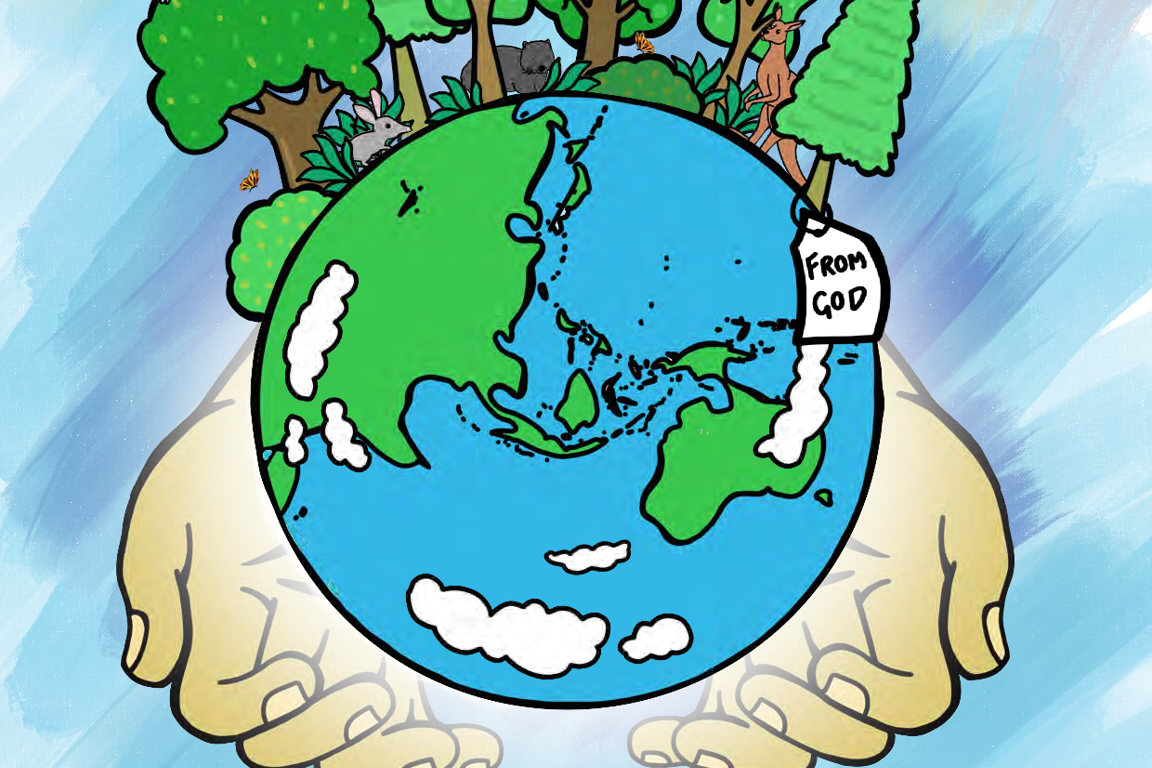Lower Primary
Care for our Common Home

How can I take care of Creation?
Teacher introduction
By the end of this unit, students will have explored the concept of creation being a gift from God and our responsibility to look after that gift. Students will explain ways they can collectively and personally care for creation.
This learning sequence has been created using the ‘See, Judge and Act’ model. This reflection–action process was first used by a Belgian Catholic priest, Joseph Cardijn (who later became a Cardinal) with Young Christian workers prior to the first World War. This approach was also recommended in the 1961 encyclical letter written by Pope John XXIII called Mater et Magistra (Mother and Teacher).
Teachers, before you start:
- Watch the new CST ’Care for Our Common Home’ film for your own background knowledge and familiarise yourself with the Lower Primary cartoon (found within the Learning Experience below) and the Care for Our Common Home Poster
- Download the various resources referenced (worksheets, slides, etc.) and have them ready to go on your computer/interactive whiteboard.
- Locate any Scriptures and copies of Church texts (all hyperlinked within the Learning Experience below).
- Familiarise and decide on the use of online or app technologies.
- Background information on Integral Ecology: Integral Ecology Framework and article by Dr Sandie Cornish: Integral ecology in the spirituality of Catholic Social Teaching
Curriculum Links
Learning Areas
- English
- Mathematics
- ScienceVisual
- Art
Cross-Curriculum Priorities
- Aboriginal and Torres Strait Islander Histories and Cultures
- Sustainability
General Capabilities
- Ethical Understandings
- Personal and Social Capabilities

SEE
Students investigate the concept of creation and what it means to take care of something.
Play “I Spy” or a variation using colours or letters appropriate for your students.
Tune in student to their senses and ask– what can you see, touch, taste, hear and smell?
Read Brown Bear, Brown Bear, What Do You See? By Eric Carle or Polar Bear Polar Bear, What Do You Hear?
See, Think, Wonder - Show pictures of Earth or use Google Earth and complete a See, Think, Wonder thinking routine. Record student responses on a chart or whiteboard to come back to later.
Look outside the classroom, use the same strategy and ask the same questions.
What do you see? Take students outside to a small area e.g. 1 m x 1 m, or a circle or other shape and repeat with the same strategy and same questions.
- Students could use magnifying glasses and go on an investigation or they could pretend that they are a detective.
- Ask them to find a certain number of things in their space.
- Link to Brown Bear, Brown Bear or Polar Bear Polar Bear as a way for students to record their responses of what they find.
- Alternatively use We’re Going on a Bear Hunt by Michael Rosen.
- Students draw a picture with the caption ‘What do you see? I see… looking at me.’ They fill in the missing information from the favourite thing that they found in their space on the ground.
- Collate drawings and make a class book.
Share - Read the class book that you created and ask
- What did you see that made you think about God?
- Are these gifts from God?
Reflect - Read the creation story from Genesis 1:1-2:4 and an Aboriginal Dreaming Creation story such as The Rainbow Serpent.
Highlight that God made all of these things – from the earth we looked at to the tiniest bug we saw outside and everything in between.
As a class decide on a sentence or two that defines what creation is and display it in the classroom

JUDGE
Using a beautifully wrapped gift, students will investigate what it means when we are asked to take care of something and what happens when we don’t take care of things we are asked to care for.
Explore - Bring a brightly wrapped gift and talk about what a gift is.
- How do we know something is a gift?
- What do you do with a gift?
- Who can give a gift?
- What are some examples of gifts?
Discuss - Treat the gift with respect and care and lead the discussion:
- How should we look after a gift?
- Why are gifts given?
- What are the different parts of a gift? Wrapping paper or bag, decoration, the gift itself, gift tags. Unwrap the gift. (rewrap the gift to later activity)
Gift Tags - Ask students to explain what a gift tag represents and when we use them. Provide gift tags and gift tag each of the things in a certain area of the classroom or school ground with the message – A gift from God. If none of the students tag each other, tag a student and talk about how we are all gifts from God too.
Display the Care for Our Common Home Poster.
Discuss the many different things in the poster that God made and ask if we should look after all of these things. Ask how we look after these things. Record responses.
When we don’t care - Pick up the gift again but this time treat the gift roughly, show no respect for it and once it is open throw it aside and make a point of showing that you are not going to care for it very well. Discuss:
- Why don’t we treat gifts badly?
- What parts of God’s creation do we not look after?
Investigate some examples where the earth or people are not being cared for. Create a list or create a chart of things we look after well and things that we don’t look after well and how people around the world are affected. For example:
- Litter, food waste, water, paper waste, general rubbish, leaving lights or air conditioners on when not in rooms.
- Plants, animals, gardens, our family, strangers, friends, pets
- Taking more than we need, using things that aren’t ours to use, taking from those who don’t have as much.
Watch the Laudato Si’ Animation for Children – This was produced by CAFOD, Caritas Australia’s sister agency in the United Kingdom.
Check if there is anything else that can be added to the chart after watching the Laudato Si’ animation.
Ask and record responses for how people are affected by the way we use things in our world?
Connect – Creation is a gift from God. As Christians we are asked to take care of God’s special gift by caring for both the planet and each other.
Complete an exit ticket. Possible ideas include:
- Foundation – Draw a picture of something that we could do better to look after creation.
- Year 1 – Draw a picture and label it showing one way we look after creation and one way we don’t.
- Year 2 – Write down two ways we look after creation and two ways we could better care for creation
- Or complete the following statement.
- Today I learnt… (written, drawn or verbal response depending on year level)

ACT
Students will investigate how they can take care of creation.
Teacher note: If your school is a Catholic Earthcare School then invite student leaders to speak to your class about actions the school is already taking to care for creation. If your school is not a Catholic Earthcare school then learn more about the program and how to get involved here.
Display or write the quote (which has been adapted for children)
“We can all be God’s instruments and care for creation” (Pope Francis, Laudato Si’ n 14)
Discuss what this might mean.
Refer back to the different ways we don’t care for creation as identified by students earlier. For each of these discuss possible actions to counteract these.
Decide on one possible action that the class could collectively work on. It might require some research about how to do it. (Here is an example of how one school does it, from a school perspective – Our Lady of Dolours –Mitchelton). For other examples refer to the Catholic Earthcare case studies.
Students choose one way they as individuals can take care of creation and pledge what they are going to do. Dependent on year level give reasons for why they have chosen this action, either verbally or in a written format.
Repeat the first activities – See, Think, Wonder around earth image, outside classroom and 1m x 1m or shape space.
Compare responses to the first See, Think, Wonder activity. What are the students wondering about now?

PRAY
Create a short class liturgy based on the class activity and individual pledges around caring for creation.
Alternatively use the Lower Primary Care for Our Common Home Prayer Service.












